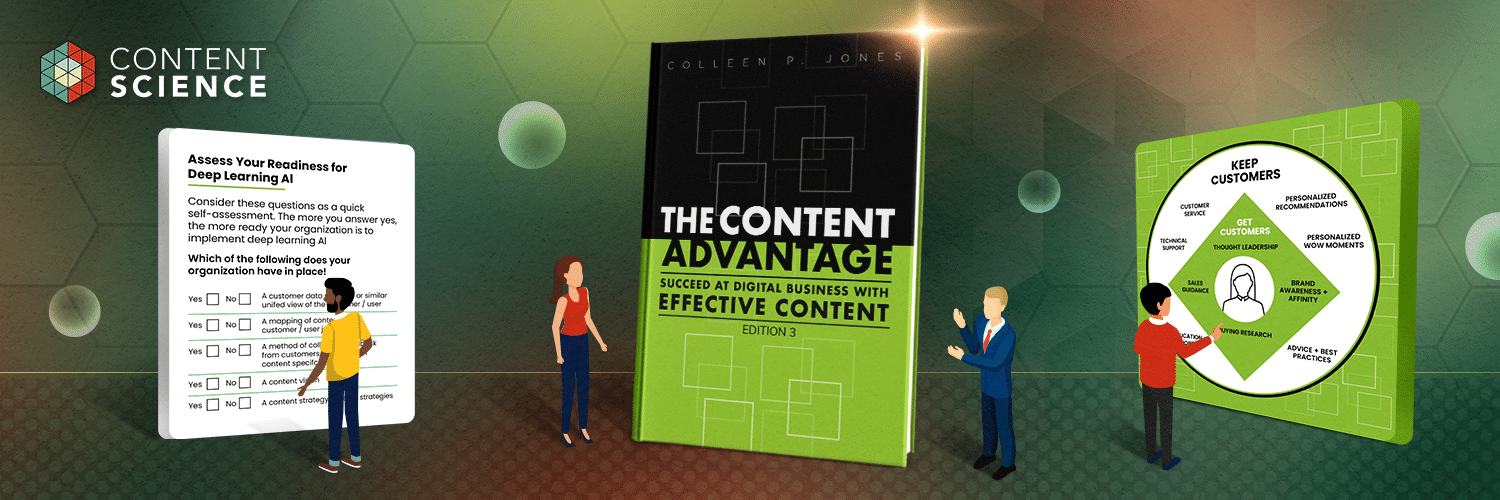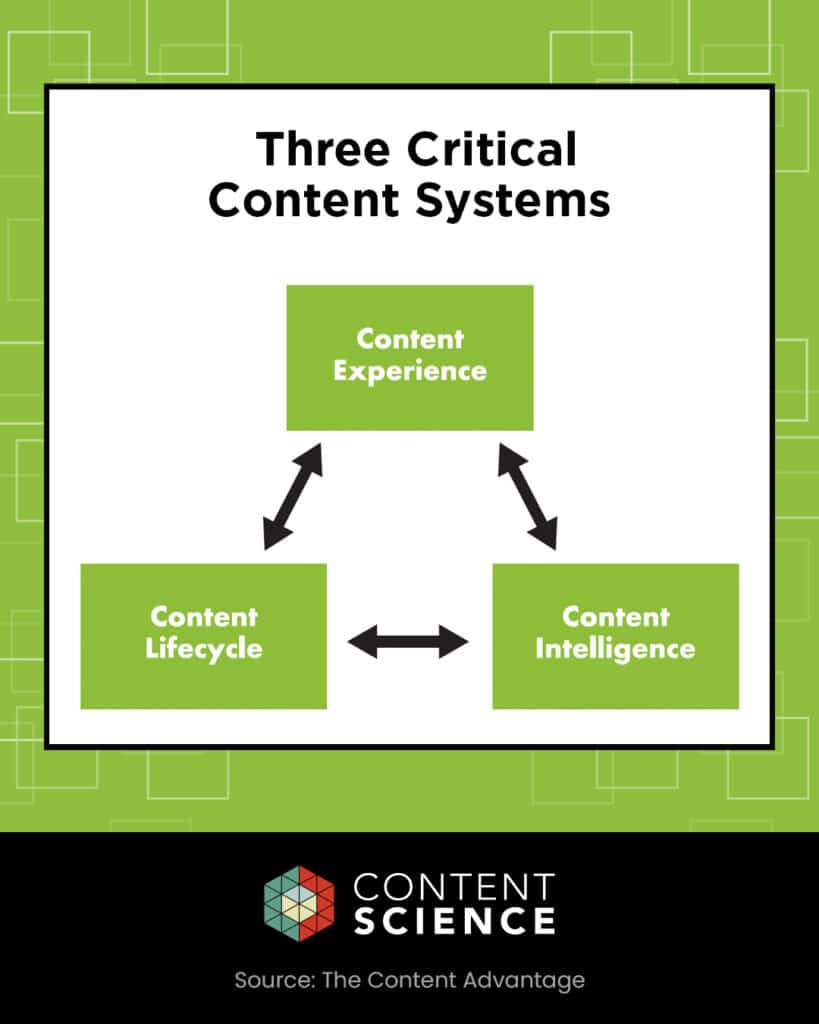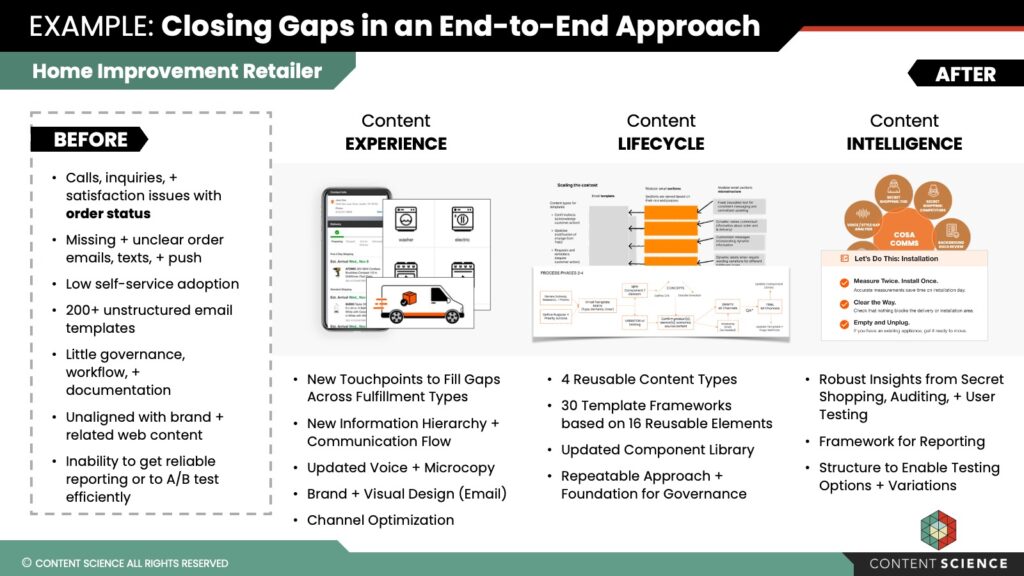
Editor’s Note: The following is an excerpt from one of the new chapters in The Content Advantage and reprinted with permission from the publisher.
“We can’t control systems or figure them out. But we can dance with them!”
—Donella H. Meadows, Thinking in Systems
“You can’t stop change any more than you can stop the suns from setting.”
—Shimi Skywalker
Take a deep breath in. Now, breathe out. You just performed an important step for your respiratory system by ushering the flow of air into and out of your body. You don’t have to understand this system completely for it to work. You can breathe in and out even if you don’t know why that’s important or how your body’s cells use oxygen. But, if you learn the essentials and consult with experts in the system like doctors or fitness trainers, you’ll be healthier, perform activities better for much longer, and recover from injuries, sickness, or allergies much faster.
Your respiratory system is a bit like a content system. It exists in a modern company or organization, regardless of whether anyone recognizes it. But smart companies have awareness at executive levels and leverage content systems—as well as their experts—so the organization can survive and thrive. In this chapter, we’ll consider what a content system is, why it’s important, and three content systems that I view as crucial.
What a Content System Is
Let’s start by defining a system. I prefer the perspective Donella Meadows shares in her amazing book Thinking in Systems:
A system is an interconnected set of elements that is coherently organized in a way that achieves something. If you look at that definition closely for a minute, you can see that a system must consist of three kinds of things: elements, interconnections, and a function or purpose.
So, what are the “elements” in a content system? Broadly, they’re content strategy, content operations (including people, process, and technology), and content assets or data. I share more specifics for each of the three critical content systems later in this chapter.
“Interconnections” are what I like most about Meadows’ definition because they’re complicated, critical for success, and frequently overlooked or dismissed—which causes all kinds of problems. I’ll highlight several of them throughout this chapter.
“Function or purpose” is what should be the content vision. Ideally, a content system is coherently organized around this vision. In the absence of vision, the function or purpose is often unstated or unclear, which puts the content system at risk of being dominated by another system with a different purpose.
For instance, if the content system related to a website lacks a vision that, say, prioritizes customer or user needs, it’s at risk of being dominated by another system. Subject matter experts in the organization might envision the website as their professional filing cabinet, prioritizing documenting their technical knowledge over customer or user needs. A void in content vision can cause all kinds of other problems, and we’ll touch on several in this chapter.
So, inspired by Meadows’ definition, here is my definition of a content system:
A content system is an interconnected set of elements—including but not limited to strategy, operations, and assets—that is coherently organized in a way that achieves a content vision.
What characterizes a content system? A content system is
- Greater than the sum of its parts.
- Dynamic, with flows into and out of the system.
- Showing a pattern of behavior over time.
- Often nested in large companies and organizations, such as having subsystems.
- Ideally resilient (bounces back from disruptions or problems) and even anti-fragile (gets stronger from disruptions).
- Increasingly self-organizing in the age of artificial intelligence.
What is the boundary of a content system? In other words, where does it begin and end? Most often, I find an organization’s view of a content system’s boundary[1] is too narrow or limited, and I suggest thinking bigger by introducing the concept of end-to-end (E2E). For example, many companies focus on content for marketing to customers, not on content for the entire customer experience. This limited view can lead to, yes, all kinds of problems—and missed opportunities.
I like the way Michael Haggerty-Villa explained how he has started to lead Teradata to think beyond the content management system in our recent conversation:
I put a stake in the ground and declared that content systems—in addition to content design and technical documentation—are one of our foundational content pillars. Yes, we need to modernize and streamline our content management system. But our focus on systems is even broader than that.
Just as the respiratory system is important to your body’s vitality, content systems are important to your organization’s success. Let’s take a closer look at why.
Why E2E Content Systems Matter
Making the most of your organization’s E2E content systems matters for three main reasons.
1 Manage Risks and Costs
A comprehensive approach to content systems can help prevent or minimize risks and costs to your organization. Table 12.1 summarizes the most common in my experience.
Table 12-1
| SAMPLE RISK | DUE TO ISSUES LIKE THESE... | DRIVE THESE KINDS OF COSTS |
|---|---|---|
| Technology Redundancy + Inefficiency | • Multiple CMSs • Duplicate content technologies • Outdated homegrown solutions • Content not optimized for technology • Lack of lifecycle workflow + standards • Limitations in technology integration | • Unnecessary technology subscriptions + support • Delays or bottlenecks due to lack of interoperability or integration • Inability to adopt emerging or better technologies like generative AI |
| Inefficient Content Operations | • Duplicate content efforts across content teams • Excessive revisions / iterations • Highly manual content processes • Unclear content processes • Lack of or unclear content intelligence to optimize | • Increased costs to produce, promote, + manage content • Inability to produce advanced content experiences, such as personalization • Costs due to delays in producing, managing, + optimizing effective content • Costs due to ineffective content (see brand, sales + support risks) |
| Loss of Brand Equity or Competitive Advantage | • Inconsistent content or content with conflicting messages • Outdated content that confuses or disappoints customers or other external audiences • Lack of content for important questions by or needs of customers or other audiences | • Decreased company value due to poor intangible assets and reputation • Loss of customers or audiences • Reduced trust or perceived value by customers or audiences • Loss of revenue, funding, or sponsorship • Decreased profit stemming from decreasing prices |
| Legal Complications | • Complaints about inaccurate or misleading content • Complaints about content that is not accessible or inclusive • Violations flagged for content that doesn’t follow industry legal regulations | • Increased costs for legal activity • Decreased company or brand value due to poor reputation • Public relation costs from public complaints, like FTC or FCC allegations |
| Delayed or Lost Sales | • Content across channels that conflicts with each other or with sales scripts • Lack of content to support key questions or needs while buying • Lack of sales enablement content for sales teams" | • Reduced revenue + profit • Loss of funding • Reduced rate of growth + momentum |
| Ineffective Customer Support or Success | • Inconsistent content or content with conflicting messages • Outdated content that confuses customers seeking help • Lack of content for important questions by or needs of customers • Inability to deliver wow moments such as personalized tips + insights | • Increased customer churn due to lowered customer satisfaction • Higher customer support costs from customers from customers not using self service + opting for more expensive channels |
Content systems matter for more than preventing the bad. They also matter for responding to volatility.
2 Sustain Reliability Despite Volatile Times
We’re all operating in an era of unprecedented change. We’ve discussed a few of the drivers in Chapter 2 and throughout this book, but allow me to summarize and expand the list:
- Technology disruptions such as generative AI accelerating to a breakneck pace and forcing companies to quickly change how they work, what solutions they offer, and even their entire business model.
- Drastic climate change and health events around the world introducing new risks and forcing new ways of remote and hybrid working.
- Political extremism around the world fueling misinformation, cyberattacks, and other threats to security, trust, communications, brand safety, and more.
- Search competition and social channel instability precipitating widespread change to making content findable and effective.
- New regulation for privacy, fraud, and AI safety driving new needs for first-party data and compliance with legislation.
- Intangible assets such as brand, data, and intellectual property becoming so important to a company’s value that even the rigorous CFA Institute recognizes them.
- Economic uncertainty such as discussion of recession and layoffs as organizations shift priorities when responding to disruption.
And this list is only a sample of the changes you and your organization likely face. By striving to have resilient and even anti-fragile content systems, your organization can be more reliable in sustaining effective content—and achieving returns from that content.
To achieve the remarkable, content systems also matter.
3 Accomplish Digital Transformation Against the Odds
In Chapter 2, we discussed that digital transformation is a do-or-die situation. We didn’t discuss the odds, and Han Solo would not want to hear them. Research by McKinsey puts the failure rate for digital transformation at 70 percent. Others put the failure rate for innovation at 70-90 percent.
You might wonder whether digital transformation is worth the effort, other than avoiding extinction? The answer is yes. For instance, companies that succeed in their digital transformation bring more revenue while reducing costs within one to two years—and if the company is public, that brings more shareholder returns.
If ever there was a forcing function for each company and organization today, digital transformation is it. You die if you don’t. You die if you do and fail. You experience unprecedented returns—and tremendous advantage—if you do and succeed.
Having witnessed both successes and failures, the Content Science team and I are convinced digital transformations fail because they do not account for content comprehensively. The content gap in digital transformation causes a host of problems, including but not limited to
- Vision omission: Content is left out of the digital transformation vision and, consequently, the rest of the strategy, planning, and implementation. This myopic view often happens if the transformation is led by the CTO or CIO. This leads to gaps and hacks in handling content and missed opportunity to achieve repeatable or compounding value.
- Casual commitment: At a large organization, if the digital transformation is not a multiyear priority in the budget, it’s likely lip service. This also leads to content gaps, hacks, and missed opportunities.
- Forgetting customer experience and success: Your company can develop the most amazing innovation ever, but if your customers don’t adopt it, the innovation is a failure. Floundering companies don’t bring customers along in the transformation through upgrading customer experience, clear communications, and useful assistance or training—all of which depend on content. This might sound obvious, but it’s a top reason innovation fails.
- Lift-and-shift migration: Sixty percent of leaders involved in migrations experience cost overruns. Those overruns are much more likely to happen when an organization tries to move data and / or content from one system to another as is, rather than invest time and resources into thorough analysis and planning.
So, embracing content systems closes the content gap in digital transformation, and succeeding in digital transformation gives your company the ultimate advantage.
Content systems will set your organization apart by providing a way to manage risk, achieve reliability despite uncertainty, and improve the odds your digital transformation or innovation will succeed. With a clear understanding of the stakes, let’s explore the elements of three content systems.
3 Content Systems Crucial for an End-to-End Approach
An end-to-end content approach ideally factors in all content and contexts at an organization. If that sounds like a lot to cover, it is. But I find an organization can cover most content and many contexts by developing these three systems: Content experience, content lifecycle, and content intelligence.

The content experience system is the strategy and operations from when your customers and audiences first start encountering your content to when they finish using it—for the entire relationship. This system ideally is closely aligned with the content vision and determining what content assets are needed when and in what touchpoints. This system also creates new content assets when needed.
The content lifecycle system is the strategy and operations from when your organization first plans content to when your organization updates or archives / deletes it. This system ideally is supplying the content experience system with the right content assets at the right level of optimization for each touchpoint.
The content intelligence system is the strategy and operations from when content research and / or measurement starts to when your organization uses insights for content decisions. This system creates a feedback loop for the other two systems.
Content Experience System Elements
The possible elements reflect the system’s focus on what the customer or audience needs.
Phases: Sample phases in the customer or user journey might be discover, research, buy, subscribe, onboard, or support.
Roles and Skills: A sample needed are content designer, UX writing, content strategy, conversational design, and specialized content creation roles (e.g. video producer if you’re creating video).
Key Tools and Tech: Content creation tools, generative AI tools, brainstorming and collaboration tools (e.g. Miro), specialized production tools. And a spreadsheet will probably come into play.
Setting It Up: Modeling the customer or audience journey and developing strategy are critical. This gets complicated quickly in large organizations with multiple customer segments and / or audiences. Content intelligence is an important input for the modeling and strategy. Make opportunities for reuse and personalization clear for the content lifecycle system.
Keeping It Going: Creating content in alignment with customer or audience needs and setting standards for that content are critical. Content intelligence is an important input for improving content or identifying new content needs. Content lifecycle helps orchestrate content into and out of the creation process.
Recommended Read: In addition to the books I’ve recommended to this point, check out Strategic Writing for UX by Torrey Podmajersky.
Content Lifecycle System Elements
The possible elements reflect the system’s focus on delivering and managing the content assets in support of content experience.
Phases: Sample phases in the lifecycle might be plan, create, source, manage, publish, update, reuse, archive.
Roles and Skills: A sample needed are content / AI engineer, content modeling, and content manager.
Key Tools and Tech: A sample might include a content management technology, a workflow management tool, a digital asset management tool, a semantic management technology, and tools for touchpoints such as email, SMS, and social media—all of which can have AI-driven features. And there likely will be a spreadsheet.
Setting It Up: Model the content—such as types, templates, patterns, taxonomy, ontology, and delivery logic or rules—and develop strategy in alignment with content experience. Model workflow to help streamline content creation and management. Consider reuse and personalization.
Keeping It Going: Establish a way to update models in light of new needs. Identify and act on opportunities to further automate or accelerate. Leverage content intelligence to optimize the content’s effectiveness and impact.
Recommended Read: For useful guidance on content modeling, check out Designing Connected Content by Mike Atherton and Carrie Hane.
Content Intelligence System Elements
We discussed content intelligence extensively in Chapters 7 and 8, and here is a rundown of its possible elements as a system.
Phases: Sample phases might be plan, test, collect, analyze, report, act.
Roles and Skills: A sample needed are content analyst, UX research, data science, data visualization, and data literacy.
Key Tools and Tech: Analytics tools, voice of customer tools, social listening tools, and dashboard and data visualization tools are important, and many are leveraging AI features. Yes, a spreadsheet will probably show up here, too.
Setting It Up: Align the strategy with the content lifecycle and content experience strategies. Define what to research, measure, and / or test, why, and how often. Assemble the data collection, analysis, and reporting tools, making them as automated as possible.
Keeping It Going: Prevent or address any blocks or delays in the feedback loop from content intelligence to content lifecycle and content experience. As the content experience and lifecycle evolve, evolve this system to collect, analyze, and report on the appropriate data.
Recommended Reads: For guidance on content-related research, check out Strategic Content Design by Erica A. Jorgensen.
Example of Aligning the Systems to Close Gaps
Smart organizations align these systems well. Let’s look at an example. A large home improvement retailer recognized they had gaps in content supporting the customer experience after placing an order. Those gaps were leaving customers confused or frustrated about their orders and, in turn, threatening important business KPIs such as customer satisfaction.
So, the Content Science team and I worked with the retailer to close the gaps using the three systems (Figure 12-2).

Content Experience: We revamped the content experience for every type of fulfillment and for every type of product and service in touchpoints ranging from email to SMS to mobile application. At the macro level we added missing communications. At the micro level we revamped iconography and microcopy to reinforce the information hierarchy and flow as well as align with brand and communication principles.
Content Lifecycle: We developed this system hand-in hand with the experience system. For example, we consolidated the 200+ unstructured email “templates” that had accumulated due to many one-off requests for changes over time into 4 content types and 30 template frameworks with 16 reusable elements. This approach helps ensure consistency while also enabling efficient creation of a new communication, if ever needed.
Content Intelligence: We gained robust insights by conducting extensive research and analysis like secret shopping and content auditing. And in developing the content experience and content lifecycle, we kept the need for efficient reporting and testing in mind. The structured approach we developed for the content lifecycle system enables A/B testing, for example.
I’m hitting only the highlights of this example, and the way these systems need to work in your organization might be very different. My point is this framework of systems can help your organization identify and close gaps in its end-to-end approach, just as they did for this huge retailer.
Handy Implications
As we view content through a system lens, a few important implications become clear. Understanding these implications can help you plan as well as communicate with stakeholders effectively.
- Silos really won’t work. End-to-end content experience cuts across all business functions and, therefore, so do the content lifecycle and content intelligence systems.
- A CMS or an AI tool is not a panacea. Chances are your organization will need a combination of tools and technology that work well together across systems.
- Setting up the system is different from keeping it going. You likely will need different roles and skills, whether you hire them in-house or use outside partners, for establishing the system compared to maintaining the system.
So, an end-to-end approach that leverages content systems will serve your organization well despite our volatile times. But how do you win support for this approach and turn it into a major initiative? We’ll answer that question and more in the next chapter.
The Content Advantage becomes available at book retailers worldwide starting November 12, 2024. Learn more or get a copy at the Content Science website.
[1] Without getting philosophical, you can draw the boundary wherever you want. It’s for discussion and decision-making, and the content system exists regardless. The more accurately the boundary reflects the scope of the system, the better the discussion and decision-making.
Events, Resources, + More
The Ultimate Guide to End-to-End Content
Discover why + how an end-to-end approach is critical in the age of AI with this comprehensive white paper.
The Content Advantage Book
The much-anticipated third edition of the highly rated book by Colleen Jones is available at book retailers worldwide. Learn more!
20 Signs of a Content Problem in a High-Stakes Initiative
Use this white paper to diagnose the problem so you can achieve the right solution faster.
Upskill with Content Science Academy
Training for modern content roles through on-demand certifications + courses or live workshops.






Comments
We invite you to share your perspective in a constructive way. To comment, please sign in or register. Our moderating team will review all comments and may edit them for clarity. Our team also may delete comments that are off-topic or disrespectful. All postings become the property of
Content Science Review.